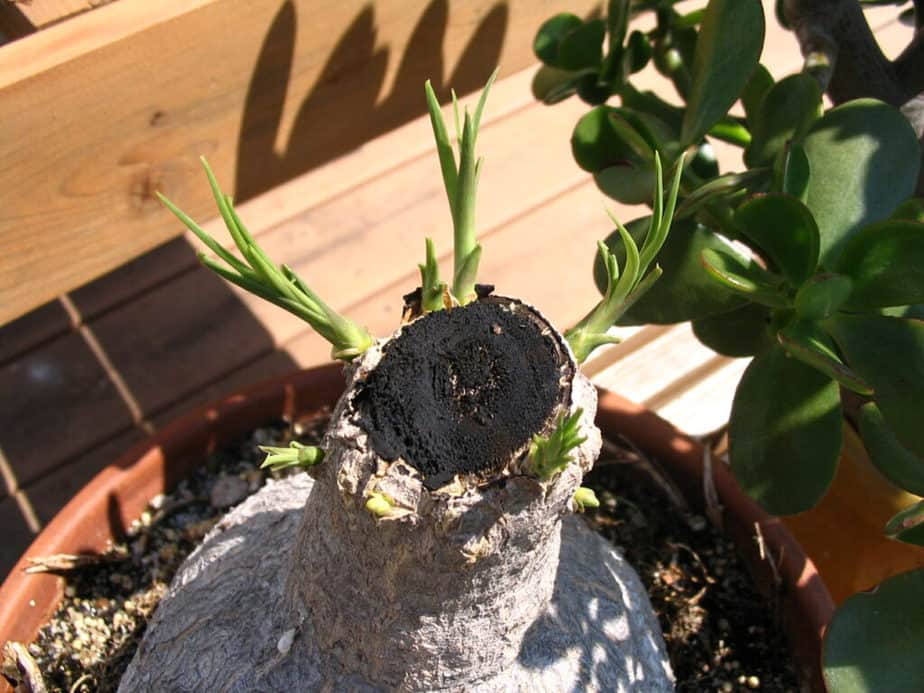Ponytail palms are great looking plants for the home or office. They can be grown in pots and even planted directly in your garden.
A ponytail palm with multiple trunks is popular for those who have been ponytail palm owners for some time. People love how great they look and receive many compliments for how cool they are.
It’s actually very easy to grow multiple trunks from one ponytail palm. This article will show you how to do it.
- Related Article: Ponytail Palm Care Guide
Grow Multiple Trunks on a Ponytail Palm
Growing multiple trunks from a single ponytail palm is simple, but you will need to take a leap of faith. Here is the process for how to grow multiple trunks on a ponytail palm:
Step 1 – Cut the main trunk of your ponytail palm
The cut area will be where the new trunks will grow and branch off. This is where you will see an average of 3 to 6 new trunks grow. Sometimes you have less, but sometimes you also have more.

Step 2 (Optional) – Coat the large wound with tree pruning sealer
Coating the main trunk at the cutting with a tree pruning sealer is optional . Since the ponytail palm is still a succulent plant, there’s been debate around this step.
Some say that it’s helped protect the cut trunk and even deter insects. Others have said that it inhibits growth and may even cause cellular damage. So it depends on if you want to try it or not.
Here’s an example of a popular tree pruning sealer online.
Step 3 – Continue to water and give it lots of bright indirect light
Continue caring for the ponytail palm main trunk as you would if you didn’t cut it. After several weeks to a couple of months, you should start seeing new sprouts.
Caring for the Ponytail Palm
After you’ve cut the main trunk, how to care for the ponytail palm is just like you would normally.
For soil conditions, use well-draining potting mix. If you’re growing them indoors, make sure to keep them well watered until they get established. Then gradually reduce watering, so they don’t dry out too much.
Use pots that allow good air circulation and drainage. You’ll notice when you buy these types of pots that they often come with holes at the bottom. These are called drainage holes. Make sure to place the hole over any existing roots before planting.
Water your plants whenever the first 1-2 inches of the soil is dry. Put a finger into the soil and you’ll be able to feel if the soil is moist or dry. Go ahead and water it if the soil is dry. Don’t overwater though or leave the ponytail sitting in soggy soil.
Ponytail palms like bright indirect sunlight. But if you live somewhere cold, then put them near a south facing windowsill. The sun helps warm up their leaves during wintertime. It also gives them extra energy to grow.
If you plan on moving your ponytail palm outdoors, wait until spring comes. That way you won’t have to worry about frost damaging its tender young shoots. Also, remember to bring along a few small stakes if it looks like it needs help to support the stems while they’re getting bigger.
For fertilizer, you can lightly feed the ponytail palm every 1-2 weeks or so if it needs it. Or you could fertilize once per month. Keep an eye on how the ponytail palm is responding to get an idea on if you need to feed it.
If you see yellowing leaves and brown leaf tips, be careful to watch how you’re caring for the plant. Those are signs that you could be overwatering, underwatering, giving it too much direct sunlight, or there’s something else wrong.
Read the Ponytail Palm Care Complete Guide.
Avoid Pruning the Ponytail Palm
The ponytail palm grows slowly, but it can live for decades and even centuries. It can grow up to 30 feet tall outdoors and around 6 feet tall indoors.
Pruning isn’t necessary because of how slow it grows. There’s no concern as it would take up to five years for it to double in size when grown indoors.
The only time you need to think about pruning is when you’re cutting the main trunk to grow multiple trunks. There shouldn’t be any need to worry about the aesthetics as it won’t have unruly growth.
What you can do is trim any brown and yellow leaves though. This will encourage more green foliage which makes the plant look healthier overall.
You might find yourself wanting to remove some branches from time to time. For example, if you see one branch starting to lean towards another, you can gently tug it back away from the other. Just make sure to avoid pulling off large chunks of bark.
Growing Multiple Ponytail Palm Trunks Final Thoughts
See how easy it is to grow multiple trunks on a ponytail palm? These are great indoor houseplants that don’t require much maintenance. They’re perfect for beginners who want to try growing tropical-looking plants inside. And best of all, they’re very affordable!
So what are you waiting for?


